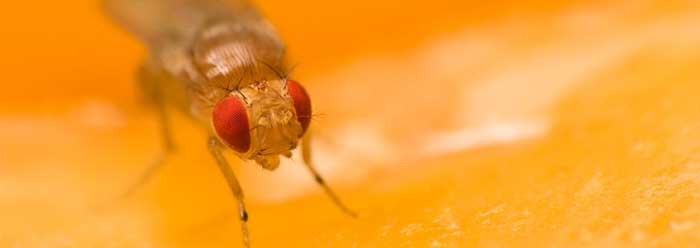The world of biology was stunned when ENCODE, a massive consortium of researchers, announced in 2007 that it had found virtually no inactive "junk DNA" in the one percent of the human genome that it intensively studied. It had expected to find massive amounts.1 Now, scientists under the consortium banner "modENCODE" have turned their attention to fruit fly genes and are making further unexpected discoveries.
In 1980, researchers completed the painstaking project of purposely altering fly genes to see what effect each would have on developing fly embryos.2 The experiments resulted in normal, mutant, or dead flies, showing that the fruit fly is unable to evolve into anything else.3 But new techniques are providing much more information about the inner workings of cells than was available when the earlier tests were conducted. And the new results show much more happening inside a fruit fly cell than was even suspected 30 years ago.
The first results of modENCODE’s research were published in Nature in March 2011.4 The team discovered 2,000 new genes, 3,000 new promoter sequences, thousands of new exons, and ten times the number of already known RNA-editing events. Most of these genetic features are involved in regulating the timing, speed, and volume of gene activity in fruit fly cells, but it is not yet clear exactly how they do it.
Biologist Eileen Furlong reviewed these results in the same Nature issue. Overall, the modENCODE results show "that some 75% of the organism’s genome is transcribed at one stage or another…in line with the widespread transcription observed in other species."5 In other words, the majority of the information encoded throughout fruit fly DNA, as well as across those species so far studied at this level of detail, has been found to be useful, valuable, and active. And it is likely that much of the remaining inactive DNA is used to position the chromatin properly, since chromatin has a specific three-dimensional arrangement within cell nuclei.6
Furlong wrote:
The sheer volume of new transcripts and putative regulatory elements, and the inherent complexity of their interactions, demonstrates how far the project has come, but also highlights the challenges that lie ahead to convert this wealth of information into regulatory networks that describe the transformation of a fertilized egg into a complex multicellular organism.5
The discovery of all these new regulatory elements and complicated interactions not only demonstrates "how far the project has come," but also demonstrates how far believers in big-picture evolution must stretch their imaginations to insist that there was no ingenious designer responsible for programming all this biological information, even in such lowly creatures as fruit flies.
Reference
- The ENCODE Project Consortium. 2007. Identification and analysis of functional elements in 1% of the human genome by the ENCODE pilot project. Nature. 447 (7146): 799-816.
- Nüsslein-Volhard, C. and E. Wieschaus. 1980. Mutations affecting segment number and polarity in Drosophila. Nature. 287 (5785): 795-801.
- Thomas, B. 100 Years of Fruit Fly Tests Show No Evolution. ICR News. Posted on icr.org July 29, 2010, accessed April 14, 2011.
- Nègre, N. et al. 2011. A cis-regulatory map of the Drosophila genome. Nature. 471 (7339): 527-531.
- Furlong, E. E. M. 2011. Molecular biology: A fly in the face of genomics. Nature. 471 (7339): 458-459.
- Thomas, B. Genomes Have Remarkable 3-D Organization. ICR News. Posted on icr.org November 15, 2010, accessed January 3, 2011.
* Mr. Thomas is Science Writer at the Institute for Creation Research.
Article posted on April 20, 2011.




